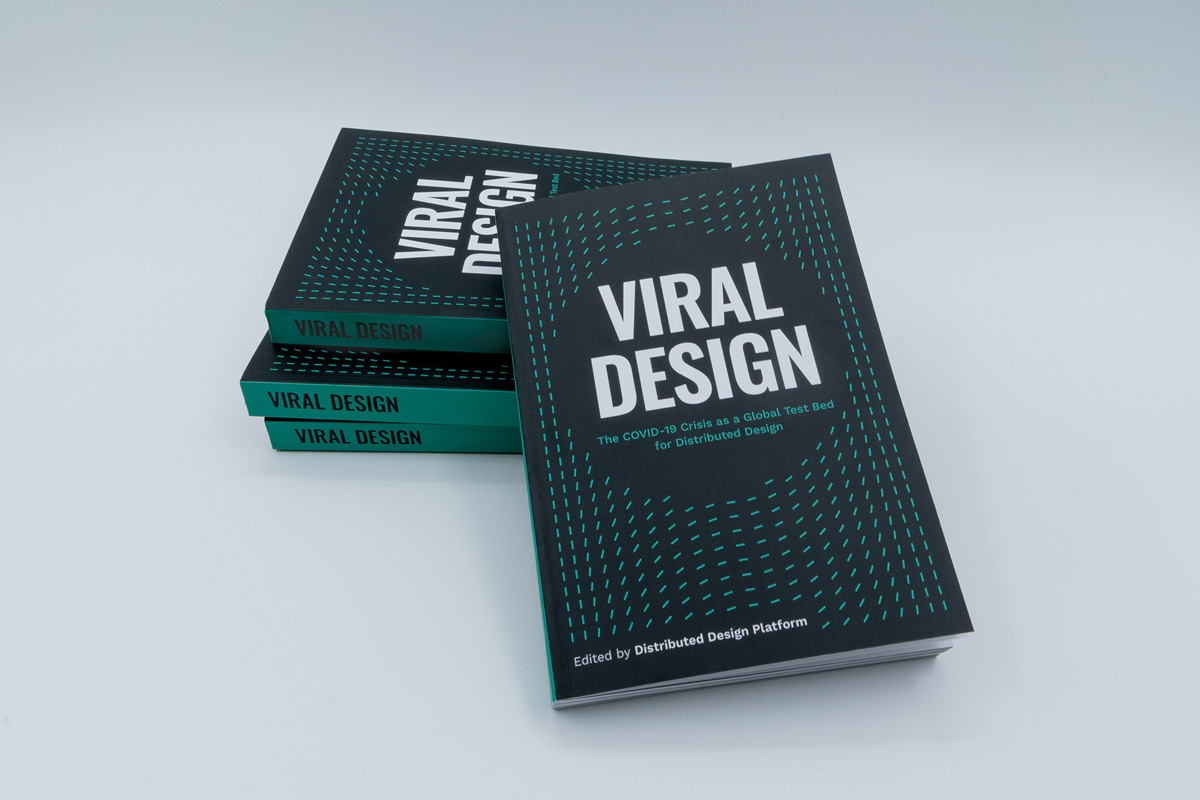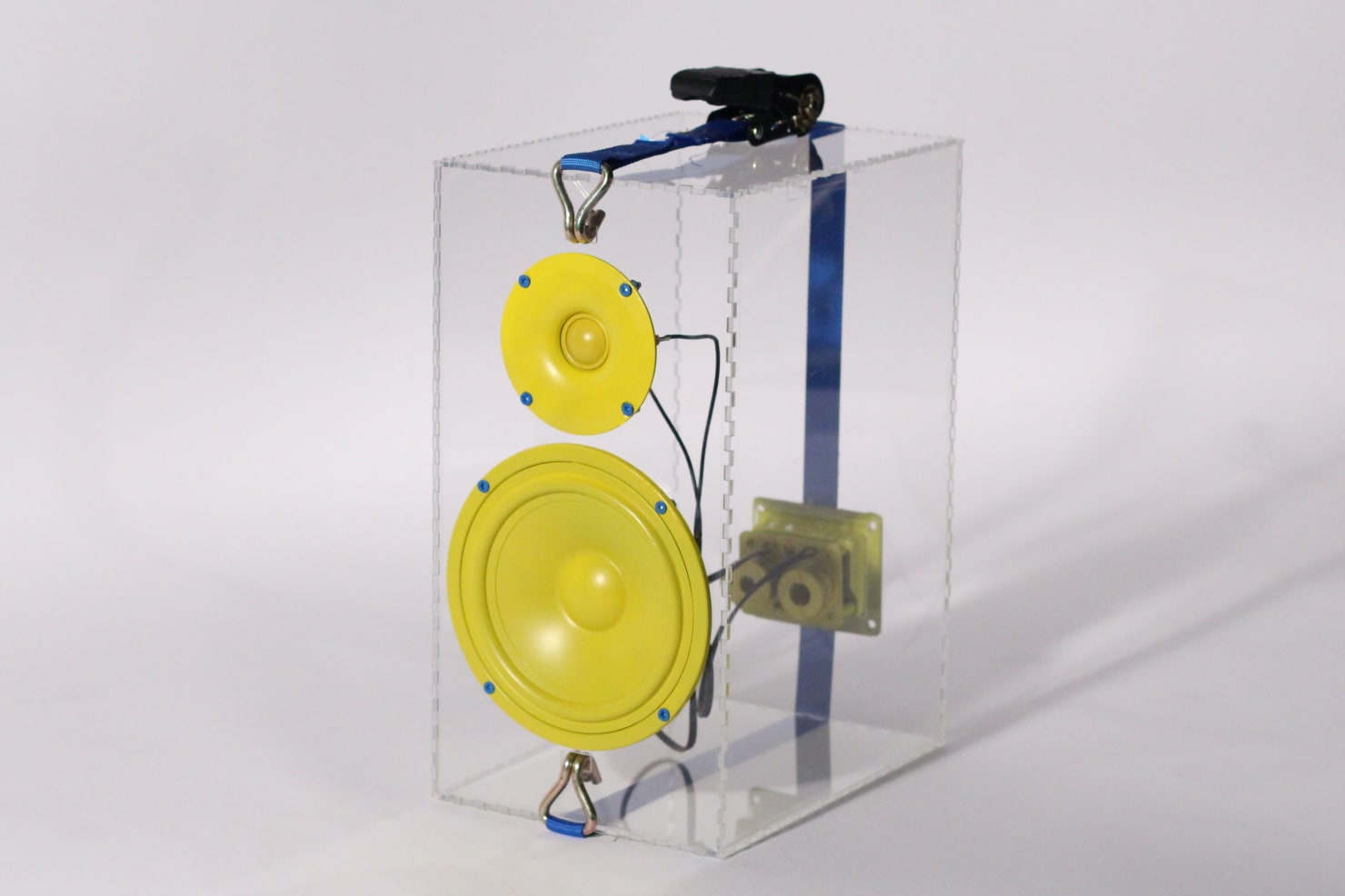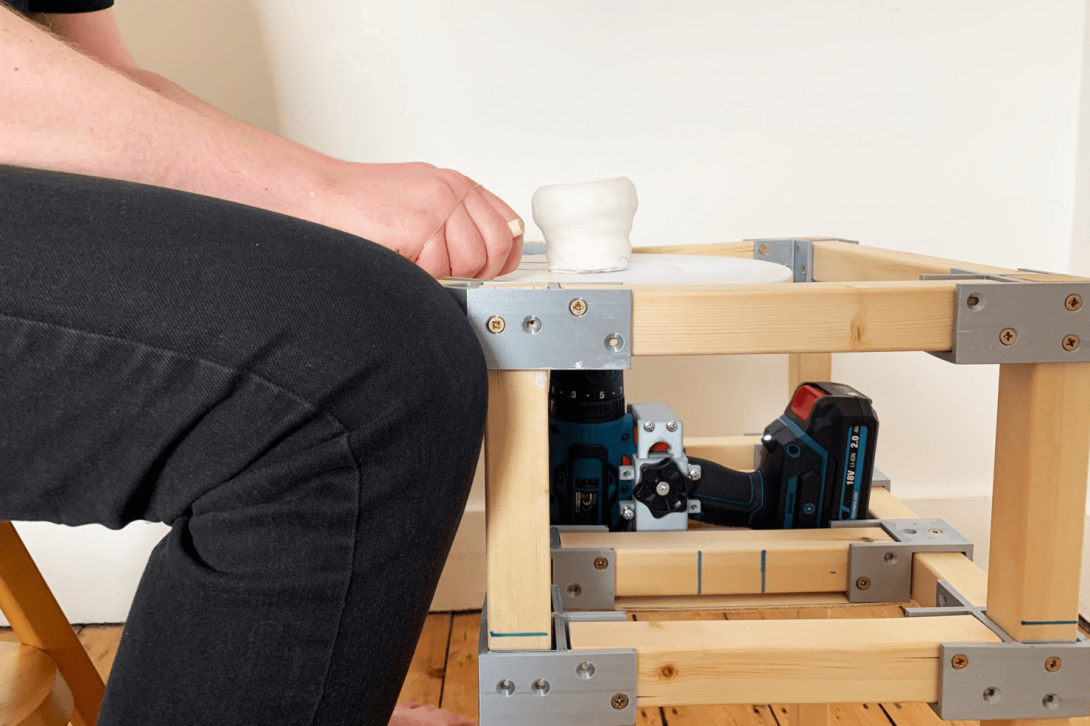Blog
Other Today is a London based design studio founded by Nat Hunter and Gareth Owen Lloyd that promotes the power of distributed and circular design to radically change how and where we make things. While it is widely accepted that Distributed Design is a way to reduce the planetary impact of products, we also believe that it has the potential to create a fairer distribution of power and knowledge — distributed does not just refer to bits and atoms but also to the distribution of knowledge, power and opportunities. As a studio, our practice is about enabling; we enable people to invent tools, share knowledge, re-code objects, craft materials and create systems to challenge the status quo. We help organisations set up makerspaces, hubs and labs; and we encourage the tools, machines and inclusive programming that creates inspiring spaces.
We are passionate about creating opportunities for makers, designers and artists to develop new work and tackle real world challenges and in line with this, we run one of four vertical studios on the Product Design BSc at Brighton University. Our students have focussed on creating designs that could be made anywhere by anyone; experimenting with novel methods of digital and social making. This has meant adopting an open design approach with accessible local materials, clear and open specifications and an emphasis on making.
We have not been designing products, but interventions into global supply chains. We have been sharing kits, inventing tools, hacking systems, re-coding objects, brewing, melting and crafting materials.
In the first term, we visited a port where products arrive in this country and a waste centre where they end up. We completed a series of micro briefs that explored modifying existing systems and distribution methods. The second term began in January with students leaving their comfort zone to have “non design” experiences. Some learnt new skills like skateboarding, others volunteered or cleaned their local area. We hacked products, interviewed experts, experimented and iterated and throughout, our studio has collaborated with the open design platform Wikifactory to share these ideas with a global network using video, open design instructions and social media.
Locked Down and Cancelled
Lockdown came late to the UK. Whilst Europe was singing from balconies and printing PPE, in March Other Today was still making the trip from London to our tutorials in the Fab Lab at the University of Brighton. At the time that lockdown was announced, our students had been preparing to turn the Lab into an exhibition space; we had built a system of CNC-cut pegboard panel displays and their projects would be on display at the work in progress show. The event would have seen hundreds of guests visiting our studio followed by a fundraising afterparty to raise money for the degree show. In hindsight, the timing of the cancellation was lucky and we narrowly missed becoming superspreaders! We were all sad to have lost the opportunity to see the projects in one place. Heading home that night we did not realise that lockdown would mean not coming back for almost a year and, for the final year students, the cancellation of their graduation show.
In the UK, people were restricted to one hour of exercise per day and only allowed to leave the house for an essential shop — an experience that quickly became apocalyptic, with empty shelves and snaking queues. Student morale was understandably low in this climate but while we were all disappointed not to meet and make together, by creating projects designed to be manufactured on Fab Lab machines and by other people, the studio had been set up well to cope with the restrictions of the pandemic.
The Virtual Studio
Studio culture, the experience of being around your peers whilst making, is so important when learning creative subjects. When lockdown happened, we were worried that we would lose opportunities for informal chats and that teaching would become isolated. Up to that point, all our teaching had been done in person. We needed a way not only to video call but to collaborate and participate. We tried what felt like every video chat software on the market and, like seemingly most of the world, we signed up to Zoom as our main video conferencing platform; it’s grid format best replicating a classroom environment and the ability to create breakout rooms perfect for tutorials and group work. Even the customisable backgrounds added a semblance of identity to the blank digital space and allowed both students and staff a degree of privacy if required.
Lockdown coincided with the four week spring break, but we had a hunch that it was important to keep a thread running through these weeks, so we arranged weekly check-ins. Only an hour long, these check-ins gave everyone a chance to just meet up on Zoom and chat, to see other students and share what they had been doing. It kept an element of studio camaraderie going, and students would join from their bedrooms, their kitchens and some from their phone as they helped relatives do shopping. We found that for some (not all) of the students, when you’re on your own in your bedroom, just seeing other faces and having a chance to say what you’re up to is a real bonus.
Although Zoom helped us communicate, we also needed a way to collaborate. In the app Miro, everyone can see their peers’ cursors moving around a whiteboard, placing images, links and post-its. Miro generously gave us a free account, and we began to discover the joys of having our research, slides and workshop materials all in one place. For teaching the more complicated concepts (for instance, doughnut economics and how to measure social impact), we created a visual mindmap of our thinking, used frames to turn the mind map into a slideshow, then set up post-it areas further down the board for a more hands-on thinking session. We broke out into three Zoom Rooms with a tutor in each one, and workshopped student’s projects for them to discover how they might measure social impact.
Resourcefulness and Resilience
In our first session, after the initial shock of lockdown had worn off and we had all finessed our Zoom backdrops and and home studio setups, we encouraged the students to think about pivoting their projects in the context of COVID-19. Did the project take on new meaning? Could it be done at home? How could the projects address this new situation? With Brighton University industrial workshops out of bounds and the city shut down, many of their ideas were no longer doable. A project turning waste from a local brewery into sunglasses could not go ahead because the business had to close and another based in Mens’ Sheds makerspaces had to rethink how to engage in participatory design in a time of social distancing.
However, the DIY ethos of the maker movement served the students well and they showed resourcefulness and resilience in the face of the shutdown. One group clubbed together to buy cheap home 3D-printers (and fixed an old Ultimaker 1) and organised themselves to print each other’s prototypes. Many changed their projects to directly contribute to their community, some built new tools at home and others turned their projects into kits to create new ways of working with people at distance. Throughout all of this none lost sight of their original brief: to create a project that can be made anywhere by anyone.
The Changing Definition of Community
“In a changing world everyone designs: each individual person and each collective subject, from enterprises to institutions, from communities to cities and regions.” (Manzini, 2015).
In the changing world of COVID-19, Other Today studio member Megan Stratford wanted to create a way for people to communicate through collective absence. Pre-lockdown research into interventions such as Guerilla gardening and yarn bombing led her to design Comunicare, a simple kit for people to share loving messages with one another during the lockdown period. Megan shared the design for the woven net on Wikifactory and people in her local area began to follow her tutorial and share messages with vulnerable friends and family and show support for key workers. During a time when people could not meet, this project addressed the changing definition of community, while boosting the morale of individuals. It created an opportunity for people to do some hands-on making during isolation, allowing creativity to fill the space made by the absence of socializing and leisure. The project was picked up by the local news and multiple Communicare nets have been made around the UK.
Dan Balint had been experimenting with new materials and discussing circular economy with local businesses when lockdown started. He struggled to continue with the work he had planned and after returning to his family home, he wanted to pivot to do something that would help others through the pandemic. He and his friends in similar situations felt demotivated by the lack of structure to the day. He had an idea to create a radio station that can be hosted by anyone, anywhere at any time using just a microphone and computer. It could be a platform where anyone could drop in and share routine and companionship. He developed a set of instructions, a website and a system so that DJs could self organise into the timetable and the radio could run itself.
Daytime programmes included music and interviews about distributed manufacturing and new materials. In addition to this, positive audio cues are broadcast throughout the day; encouraging people to drink water and go outside to exercise. In the evening, live DJing had an accompanying video platform to bring people together online. Over a period of two months, the platform has developed into a community of regular lockdown listeners, music enthusiasts and talk show hosts from over 30 different countries, all helping to keep each other afloat during these difficult times.
Kits for Socially Distant Interaction
How do you make furniture when the wood workshop has been shut down and you can’t buy tools or materials? Ben Palmer had been researching alternatives to flat pack fast furniture before lockdown and was collaborating with a CNC workshop to design a method of using their plywood offcuts to make new products. Post-COVID, the project became OFFCUT and focussed on teaching people skills to build their own DIY furniture. The stools are simple to make, using only one shape with varying lengths, that can be easily cut from awkward offcuts of wood. The aim is to develop people’s confidence in making, encourage an appreciation of waste as a resource and to enhance their skills and the likelihood of them continuing to participate in making. To get around the restrictions, Ben hacked an IKEA stool into a bike rack and used his allotted one hour of exercise to cycle to local workshops and collect materials. He then packaged the pieces and cycled them to people’s houses, dropping the package off on people’s doorstep who then followed his instruction video to make at home.
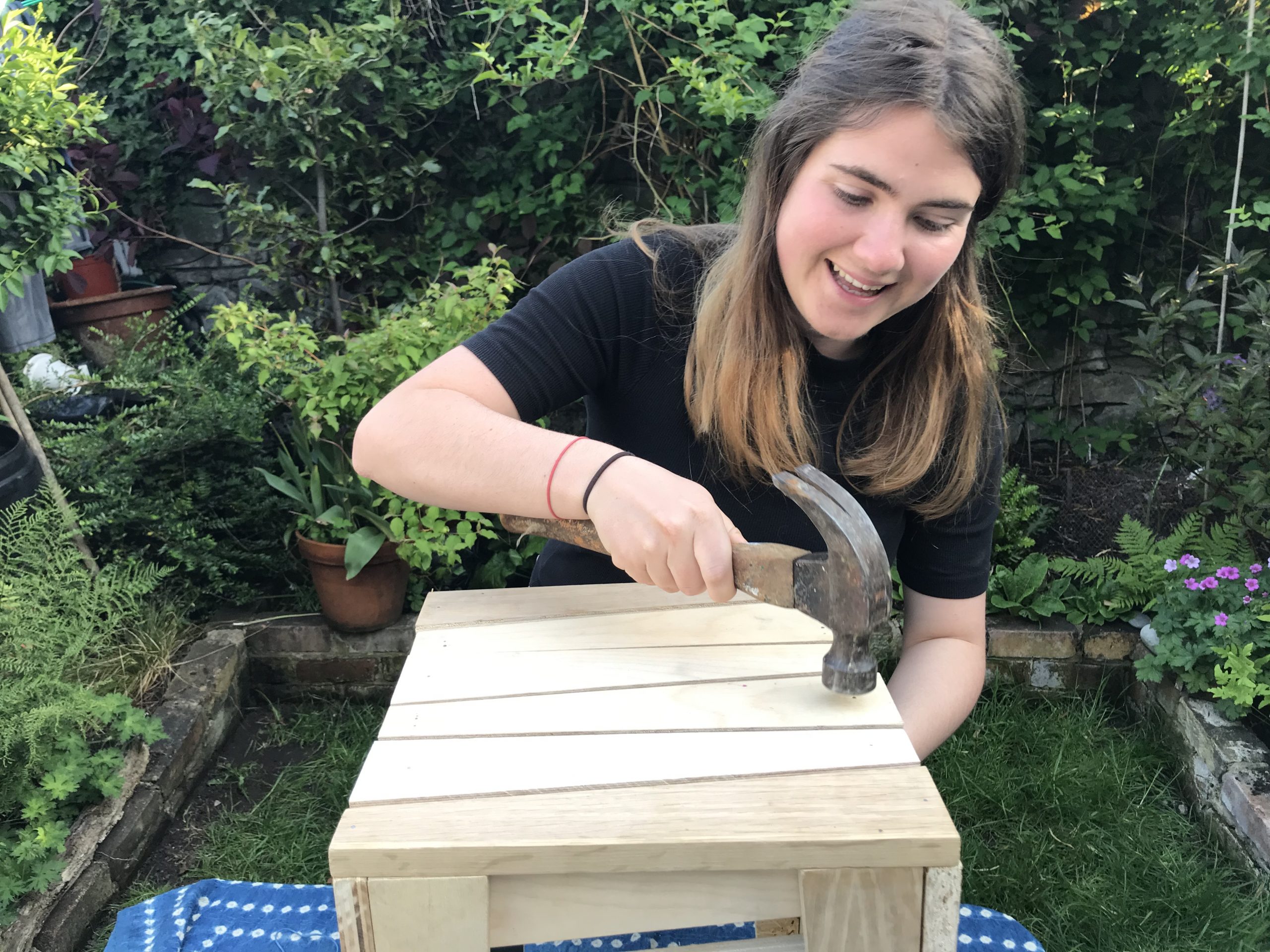
Coronavirus created a need to control objects in the world without touching them so Joe Lyons asked the question “How might we control the world with our eyebrows?” Like Ben, Joe pivoted to an open-source toolkit for people to learn how to control the world with their face from home. He developed a physical set of parts, designed as an educational tool and a digital resource which allowed people to create expressive new interactions. Frustrated at the level of interaction he was having with his friends, he created ‘Eye Brow Pong’ a game of pong that is controlled by you and your friends faces.
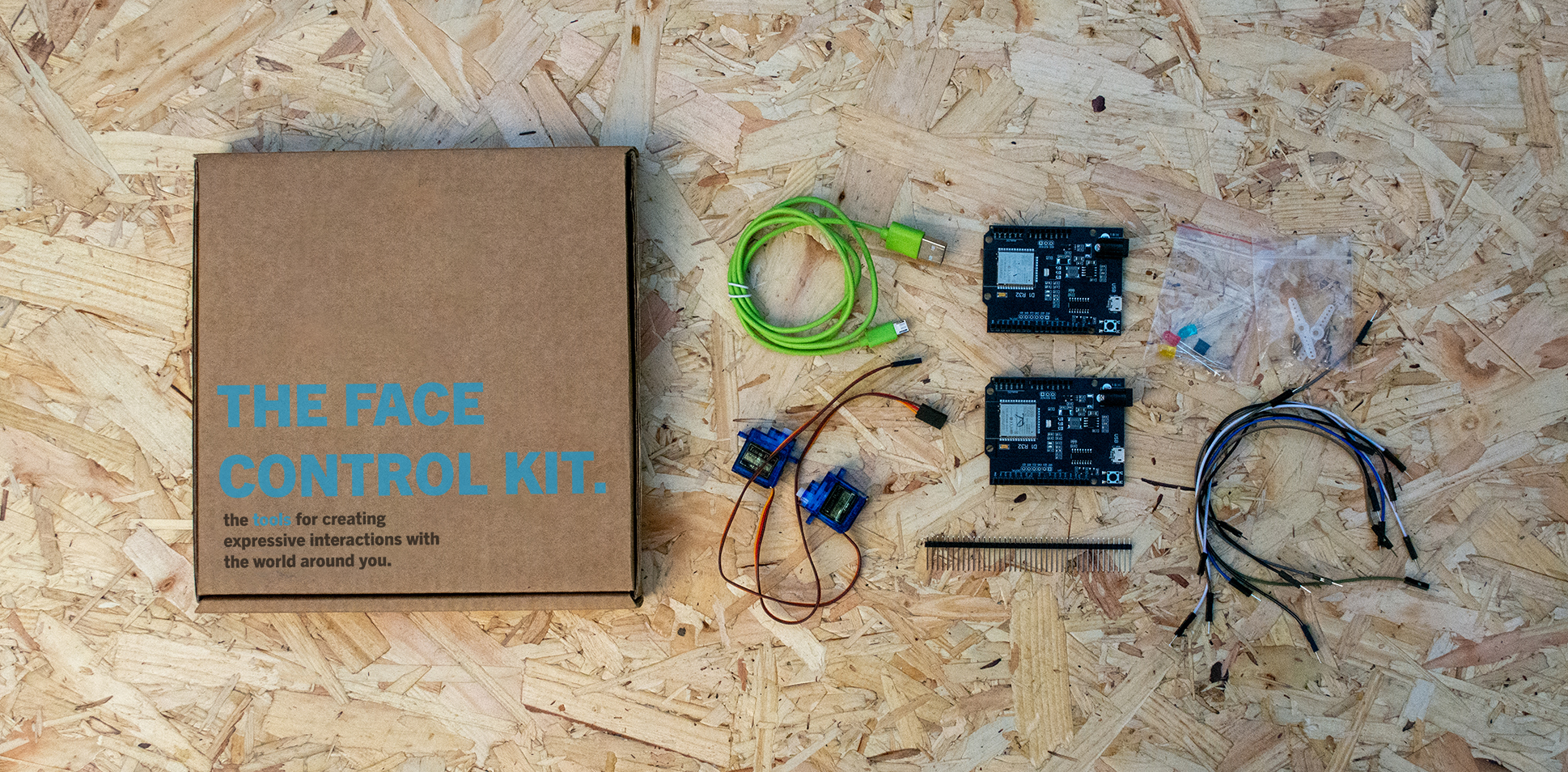
Workshops for the Home
Students responded to the closure of the workshops by building their own making spaces and inventing new, accessible tools. Markos Georgiou created Biogun, a handheld extruder that offers new ways of making with biomaterials. In the UK, we were only allowed to go to supermarkets to get essentials, for Markos the cheap electric screwdriver in the central aisle of Aldi was an essential. Using bits of plumbing and 3D-printed parts he hacked the function of the drill to become a homemade extruder. Combined with recipes from the Materim website, the Biogun provides new and fun ways of exploring biomaterial forms beyond the usual flat sheets.
Ewan Brammall also found a starting point in the power drills and wanted to create a workshop at home kitted out with the kind of expensive tools that you might find in a makerspace. For under ten euros he made his first tool — a pottery wheel jimmied together out of a hand drill, some wood and a bucket. He developed this idea further and created a set of instructions and 3D-printed parts to turn a hand drill into many more complex machines. To extend his project from just one machine to many, he built a website with a community where people could share their designs.
When Lawrence Parent had access to the workshops at Brighton University, he was spending time in the engineering department’s concrete lab, using their massive steel pressurised moulds and experimenting with firing clay soaked loofahs. Lockdown put the brakes on this project but he was lucky enough to have a garden and friendly neighbour with a leftover bag of cement — enough to build a casting workshop in his back garden. Despite the situation, he managed to iterate hundreds of his “Living Blocks” and developed them into a recipe shared on Wikifactory. The bio-receptive building blocks can support plant and insect life. By hand making moulds in his back garden and filling them with ice, balloons and out-of-date tomatoes, Lawrence was able to create a complex form suitable for plants to live in. Because of the limitations, his final instructions for distributed design are easy to follow and really accessible — you can’t help but wonder whether lockdown made this a better project!

A New Normal
In 2017, we curated an exhibition called A New Normal. It brought together makers working in distributed design who had created real products that could be shared digitally and made locally. We were optimistic when we chose that title, excited for the possibilities of theory made real. The phrase has become the catchphrase of the pandemic but hints at an uncomfortable permanence for this situation. We have been teaching our new normal of distributed design and seen it prove to be a suitable approach to the global new normal we find ourselves in. We are proud of what our students have achieved, and while we set out pre-covid to teach resilience and resourcefulness as skills for this rapidly changing 21st Century, they were thrown in the deep end. Most of them surfaced quickly, pivoting their projects, supporting each other and did the best they could. However, we did see a major challenge of socio-economics, with our students in varying degrees of comfort and support. When one student is at home with plenty of space, a garden and a workshop, and another student is sharing a house with multiple generations, all shielding, no broadband, and also working for money — the students are not learning on a level playing field. Although we did our best to support them, we did see some dropping off in attendance and others struggling to keep up with the work.
This massive test of remote learning has shown how the physical university environment can go some way to compensate for inequalities. COVID has been a moment to reflect on the human aspect of distributed design, yes a design can be made anywhere by anyone — in principle. But not everyone has access to the tools or space to make. Many of the students tried to address this with simplified workshops and DIY methods. But is there a risk here of distributed design only being suitable to either simple DIY projects or complex digital fabrication? Equality is not distributed, design needs work harder to not just simplify products but expand access to the skills and tools needed to make them. The next academic year will not be “business as usual”, and so we need to learn from this experience and to make sure ALL of our students can build the resilience that comes from a maker mindset.
